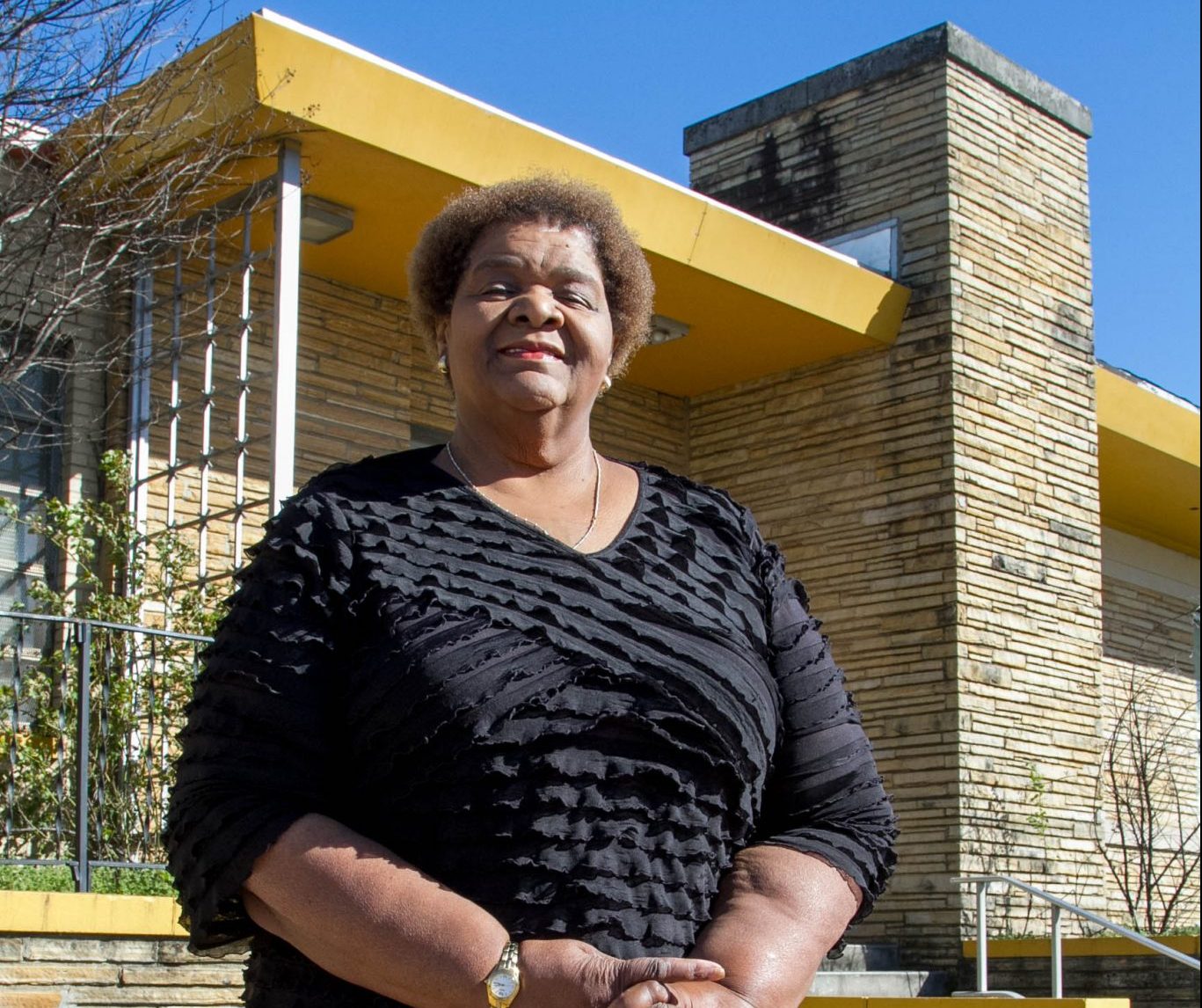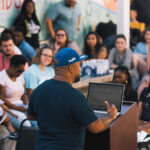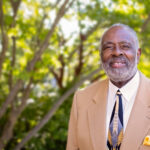Join ERLC and TGC for “MLK50: Gospel Reflections from the Mountaintop,” April 3 to 4 in Memphis. Learn more at MLK50conference.com.
The girl waiting for the middle-school bus in south Memphis in 1998 was clearly pregnant.
“She was so innocent and young—a child in 7th grade,” said Carolyn Bibbs, who spotted her there. “It didn’t seem right this baby was pregnant.”
It wasn’t the only thing that felt wrong in Memphis. Thirty years after Martin Luther King Jr. was assassinated there, the city had made its way through race riots, school desegregation, and a white middle class fleeing both.
Violent crimes such as homicides, robberies, and forcible rapes rose 13 percent from 1992 to 1997. (Aggravated assaults rose 67 percent.) A record 213 people were murdered in 1993.
Meanwhile, the median household income was just $32,274 in 2000, compared to $42,148 nationwide.
“I began to pray,” Bibbs said. (She still gets up at 4 a.m. each morning to do so for several hours.) She asked God to “please send someone to our neighborhood to help our children.”
Then one morning, she realized God had sent someone.
It was her.
Bibbs asked the principal of the local high school if she could have an after-school program, but the woman never got back to her. So Bibbs printed up flyers and handed them out, listing “To Be Announced” as the location. (She eventually landed on the third floor of the school.)

Bibbs had no money, but “twisted the arms of some of my friends” to donate their skills. The students—around 70 of them in grades 7 through 12—came every day for several hours, and Bibbs and her friends helped with homework. They taught drama, dance, music, and taekwondo. Once a week, they’d have a “jam session,” and then spend 10 minutes telling the kids “the word of the Lord.”
“By the end of the first year, every one of them had asked the Lord into their life,” Bibbs said.
Over the next two decades, Bibbs expanded the after-school program, purchased a warehouse, started a private Christian school in it, and passed out more than a million meals.
But even though she has seen hundreds of success stories—children who have come to Christ and gone to college and broken out of poverty—her South Memphis neighborhood has experienced little change.
Memphis’s murder rate dropped in the 2000s, then rose again—in 2016, the 228 murders were the most in two decades. The city now has the fifth-highest homicide rate in the country—worse than Chicago, Los Angeles, or New York City.
“It’s like the O.K. Corral out there,” one anti-violence advocate told the Associated Press.
Of all the neighborhoods in Memphis, Bibbs’s is the most dangerous—by some counts, it’s even the most dangerous in the United States. In South Memphis, the chances of becoming the victim of a crime are 1 in 9.

“Other than [increased] gang involvement, it’s pretty much the same,” Bibbs says of the place where she’s worked for three decades. “I used to get frustrated because I didn’t see the change I wanted to see.”
She’s not the only one. Memphis is full of churches—of all U.S. cities, it’s ranked 5th in the number of religious venues, and 24th in biblical engagement. Many of those churches—and other nonprofits—are hard at work in the city, donating and volunteering to cover financial needs, operate a mobile dental clinic, tutor in the public schools, and work on race relations. Last year, Memphis was ranked the most generous city in America—$6 of every $100 earned was given away.
“The environment is being penetrated, but not enough,” said Hope Church senior pastor Rufus Smith. “The fact that Dr. King was killed here sort of froze Memphis into this malaise.”
He’s hoping the 50th anniversary commemorations next month—and the national attention that will bring—will “break the spell” and prompt business, political, and religious leaders to address Memphis’s issues with a “multidimensional, coordinated, strategic approach.”
Whether or not that happens, Bibbs will keep opening her warehouse doors.
“You can’t win them all; you just win you who can win,” she said. “It’s like throwing a net out into the sea and trying to grasp as many as you can.”
Her answer is “typical” for those who work in Memphis, said pastor Sandy Willson, who retired last year after 22 years at Memphis’s Second Presbyterian Church. “You cannot look for your daily motivation from what sort of visible changes you’re seeing in the general atmosphere. . . . We’re known to have a larger scale of problems per capita, but if you’ve been there a while, those aches and pains draw you closer to the city and you love her even more—like a mother caring for her wounded child.”
Ordered by God
Bibbs isn’t from Memphis. She grew up in Kansas City, Kansas, the second child of a mother and father who waited more than a decade for her.
“My mother couldn’t have children,” Bibbs said. One night at a revival, a pastor told Bibbs’s mother she would have a child, even if it took 15 years.
Almost 15 years to the date, Bibbs’s brother was born, then Bibbs herself two years later.
“Having my brother made her turn back to the Lord,” Bibbs said. “All we heard was, ‘Your steps are ordered by God.’ My mother would remind us daily that we were to be used by the Lord.”
Seeing the children at the bus stop—hungry, wearing ill-fitting clothing, pregnant—“touched my very core,” Bibbs said. “I knew how intentional my family was to provide for us a safe, protected place. Then I looked at the kids, and they didn’t have anything. A lot of them still don’t.”
Don’t Have Anything
Memphis’s poverty rate rose to 27 percent in 2016, compared to 16 percent in Tennessee and 14 percent in the country. Among African Americans, the poverty rate is 32 percent, the median household income $31,471. And among those who live in South Memphis, the poverty rate is 36 percent, with a median household income of $25,840.
In 1998, Bibbs didn’t have much either. After her first year of the after-school program, she began applying for grants so she could pay people to work in the program. Then she got strategic, writing out a ministry plan and chasing down community developer John Perkins in California to run it by him.
“He went through my whole plan with me,” she said. His only suggestion—put it on a five-year timeline.
It felt ambitious, but within five years, “everything I wrote down, the Lord brought it to pass,” she said.
Education
“When I started in the community, there was no boys’ club, no girls’ club, no anything,” Bibbs said. “Our kids were just suffering.”
Carver High School, where Bibbs was holding her after-school program, was old and outdated. The board approved a $10 million renovation in 1997, but it never happened. As families moved out and gangs moved in, enrollment plunged—from 2,200 in its 1961 heyday to 200 in 2016. (With $3.5 million in deferred maintenance needs, and ranking fourth from the bottom in state test scores, the school was shuttered in 2016.)
But enrollment in Bibbs’s program was taking off. By her second year, she had expanded into three more local elementary, middle, and high schools.
“I saw that several of the children were falling through the cracks, so in my second year I began to think, Why not start a school?” Bibbs said. “We’ll keep the after-school going, but give kids not only education, but hope in the Lord.”

So she did. She put Creative Life Preparatory School in a 21,000-square-foot warehouse, which she renovated with more grant money.
Bibbs’s other funding comes from tuition, donations (the after-school program costs about $350,000 annually), and the state Department of Human Services.
Because in addition to offering nine ministries—from a kids’ church to weekly Bible studies to summer camp—Bibbs has also been feeding her community.
‘It Did Something to My Heart’
“When you begin to work in a community, you begin to learn the conditions of the people you serve,” Bibbs said. Twenty years ago, “I’d go into houses and they wouldn’t have furniture. The kids wouldn’t have clothes. They wouldn’t even have refrigerators.”
She remembers being offered a glass of water by a child, but when he opened the fridge, she could see nothing but an empty jug.
“They couldn’t even give me a glass of water,” she said. “It did something to my heart, seeing that over and over again. I said, ‘God, there ought to be some kind of way we can send the kids home with full stomachs.’”
So she went to the grocery store.
Over the past two decades, they’ve made more than 1.5 million meals for kids.
“Whatever money we had, we bought hot dogs and bologna,” she said. She shopped at the food bank, where they’d give her deals because they knew what she was doing. She bought ham and peanut butter and jelly and, along with her friends, started making sandwiches.
“We did it for years without any government funding,” she said. “We just prepared meals for the children. In the summertime, we would do sack lunches with vegetables and sandwiches and milk and fruit.”
Eventually, she teamed up with the school nutrition program under the state Department of Education and the federally funded Child and Adult Care Food Program.
Over the past two decades, she figures, they’ve made “easily more than 1.5 million meals for our kids.”
But it still doesn’t feel like enough.
Not Enough
Bibbs has about 60 students at her Creative Life Preparatory School and Daycare. After school, kids pour in from the surrounding public schools—for the next few hours, she provides homework help and Bible studies and theater classes to about 130 children.
“We’ve got a big facility, and they’re all over the place,” she said.
But there are thousands of children in South Memphis. And they aren’t doing well.
“Poverty in the U.S. continues to drop, but it is increasing in the entire Memphis area,” a new report from the University of Memphis stated. Child poverty in Memphis rose to almost 45 percent in 2016, compared to 23 percent in Tennessee and 20 percent nationally.
When researchers split out African-American children, they found that more than half of Memphis’s black children live in poverty (52 percent), compared to 41 percent in Tennessee and 34 percent nationally.

Part of the problem is educational—31 percent of those in South Memphis did not graduate from high school. Part of it is family structure—in one of South Memphis’s zip codes in 2013 (38126), almost every child younger than 6 lived with a single parent (96 percent). Part of it is straight-up crippling poverty—40,000 children in Shelby County live in households that earn less than $10,000 a year.
And part of it is the lifestyle of drugs and crime that is fed by—and feeds—the lack of education, stable families, and well-paying jobs.
“While we’re doing great works in silos, the magnitude of scale is just too much,” Smith said. “Therefore the progress has been slow to impact a critical mass of people.”
Randy Odom, who heads the Memphis Athletic Ministries (MAM), says the same thing.
“I’ve been here since 1992, and the poverty has been constant,” he said. “When Martin Luther King Jr. got assassinated, it was a turning point. . . . How would you feel, if the person who came along to bring freedom, to bring hope, was killed in your city?”
MAM is one of Memphis’s largest ministries, serving 700 children a day with a structured literacy program, homework help, team sports, and daily devotionals.
“I’ve got 45 full-time people, 50 part-time support staff who are totally committed to the mission, and 20 years of ministry,” Odom said. He knows he’s making a difference, but like Bibbs, it doesn’t feel like enough.
“I have 200 kids in the gym at the Olivet Fellowship Center,” he said. “But there are another 800 at the school down the road.”
Individual stories—not widespread change—keep him going.
Plugging Along
“I’ve got eight to nine staff working for us that were from the community,” Odom said. “That’s what keeps you going—God calling you here, but also you see the fruit of some victories. And so you keep plugging along.”
Terence Gray is plugging along with youth at Downtown Church. He sees how hard it is for them to break out of the inner-city culture.
“Our students leave church and return back to an environment where they are tempted with gang violence and drugs, and sometimes they succumb,” he said. “When you are working to redirect kids out of these patterns of behavior, it can be very discouraging to see them acting out.”
So Gray reminds himself that he isn’t answerable for anyone else’s faith.
“The Lord is responsible for the life change,” he said. “If I really believe people are saved by grace, that their hearts are regenerated by God, that he’s the one who saves and sanctifies them, then it helps me to know that while a situation seems impossible to me, it’s not impossible to God.”
And once in a while, God gives him “glimpses of grace,” such as when another student who had been getting in trouble at school and church helped lead an evangelism evening, and “just exploded, loving on people and praying on people.”
“When that happens, I’m like, ‘I didn’t do that. I couldn’t do that. That’s the Lord,’” Gray said. This student “might ask me a spiritual question out of the blue, and I think that’s the Lord kinda winking at me—‘Though he may seem rough, I’m working.’”
Is there enough evidence for us to believe the Gospels?
 In an age of faith deconstruction and skepticism about the Bible’s authority, it’s common to hear claims that the Gospels are unreliable propaganda. And if the Gospels are shown to be historically unreliable, the whole foundation of Christianity begins to crumble.
In an age of faith deconstruction and skepticism about the Bible’s authority, it’s common to hear claims that the Gospels are unreliable propaganda. And if the Gospels are shown to be historically unreliable, the whole foundation of Christianity begins to crumble.



































